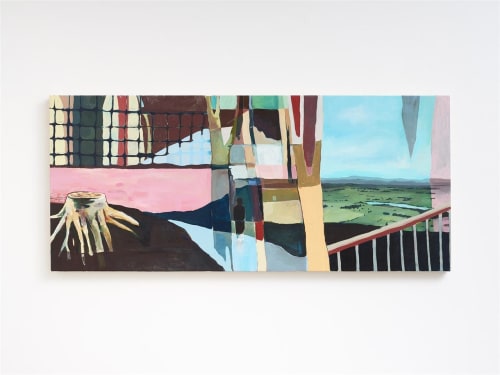“Paths weave through trees, people’s bodies disappear behind bends, rivers snake through the land. The calm waters rush by, chaos is present if closely observed.” - Llenyd Price
Sanderson are pleased to present the exhibition Secrets in the Array, an exhibition of new paintings by emerging artist Llenyd Price. Price recently completed a Master of Fine Arts at Whitecliffe College of Arts and was part of Sanderson’s Emerging Artists exhibition in 2022.
This new body of work continues Price's investigation into the layered and often conflicted relationship between the people and land of Aotearoa. Landscape painting as a genre has a deeply colonial past. Painters of the early 19th century were employed to present idealised depictions of Aotearoa as promotional material for prospective settlers. Acknowledging this historical weight; these paintings present a personal investigation into the artist’s internal questioning of self-identity and their own place within Aotearoa’s natural environment.
Price’s featured terrains are inspired by specific locations within the Waikato and Kirikiriroa, where they spend time walking and exploring. The artist first ventured into these areas in the hopes of attaining a ‘clearer’ mind. With mental health issues looming, these spaces help with finding ways to temporarily escape from ‘reality’. As a consequence, the artist developed an interest in the native bush; often found scattered alongside building construction zones that edge into the natural ecosystems and sections of farm-land.
While considering the continued impact of colonialism on the land; environmental concerns relating to farming and agriculture arose for the artist, particularly with relation to the impact on our soils and waterways. The rapid increase in industry and groundwork in Aotearoa has meant native plants are under pressure, further worsened by the introduction of invasive and non - native flora and fauna.
The artist enjoys observing how structures like barriers, fences, paths and signs influence and direct the way people move through spaces and interact with the landscape. This brings forth questions about the ways we conform, restructure and alter our personal observations and interactions with our surroundings.
Just as one’s perception of the world varies from person to person; the artist’s landscapes encourage fluidity of interpretation through their compositional arrangements. These paintings, derived from drawings, photographs, and memories are fuzzy at the edges; in the same way that memories lose their clarity if held too tightly. Constantly oscillating and refocusing, these scenes offer alternative ways to encounter and experience the world, questioning the way reality exists through our physical interactions and within each of our imaginations.

